#hugelkultur bed
Explore tagged Tumblr posts
Text
August 2024: A Little Bit Of Everything
Monday harvest:

Tuesday harvest:

Seeds we collected from this year's leeks:


Wednesday harvest:


Curbside find of the week. These 100 gallon stock tanks run for around 130 bucks & this one was free. We're going to use it to make a container version of a hugelkultur bed:

Friday harvest:

These are some of the summer squash that volunteered in our front bed. They appear to be a hybrid of lemon squash & either straightneck or crookneck squash:


Tersa sphinx caterpillar:
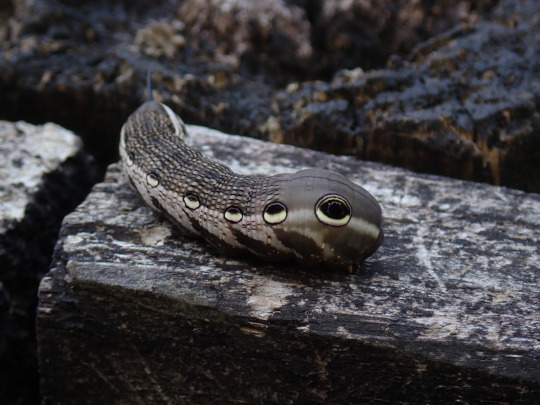


Seen while walking:




Found while walking - two rocks... one obviously evil:

We have volunteer pumpkins in the front bed starting to make:

A volunteer crookneck squash from the front bed:

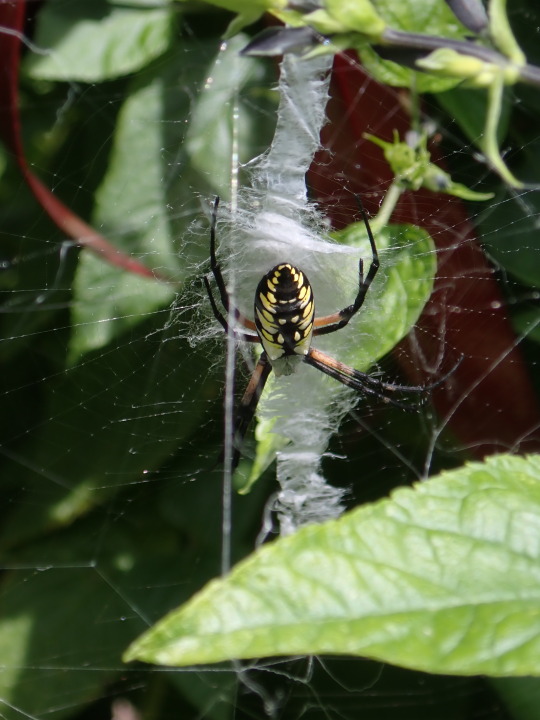
Sunday harvest:

I felt something on my back & snapped this photo:

And here it is biting me:
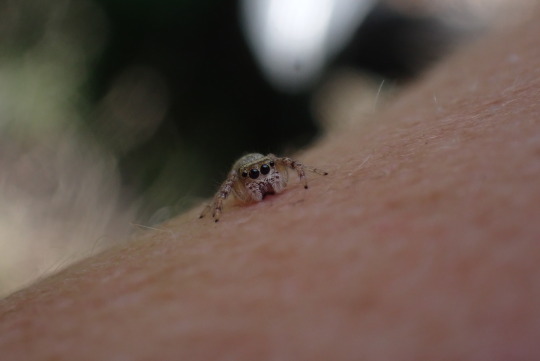

Out of focus shot of a hummingbird feeding at our chive blossoms:

My queen planted some lemongrass today to take the place of the Bells of Ireland that had gone to seed:

#garden#backyard garden#gardening#vegetables#homegrown#harvest#cucumbers#pole beans#summer squash#yellow straightneck#tomatoes#juliet#okra#clemson spineless#seeds#leek seeds#seed saving#hosta#dragonfly#flowers#clematis#curbside find#rubbermaid stock tank#hugelkultur bed#lemon squash#straightneck squash#crookneck squash#fairy lights#night photography#caterpillar
18 notes
·
View notes
Text
SAVANA garden beds can vary in height and size for any garden space. From square to round to rectangular, no matter the shape of your garden, we have the perfect solution.
#raised beds#raised garden beds#raised bed gardening#raised bed garden#spring garden#spring#how to raised bed#how to#raised garden bed diy#galvanized garden bed#hugelkultur raised bed#garden#gardening#gardening for beginners#vegetable gardening for beginners#raised bed soil#raised bed garden soil#drainage#garden tips and tricks#gardenprep#raised beds diy
0 notes
Text
The problem with gardening is that you'll be filling up a water trough for the chickens and you'll see that big dangerous dead tree you need to get cut down and you'll think 'I wonder if the tree guys will let me keep the wood, I can use it for those hugelkultur beds I've been meaning to set up on the slope out there" and "oh I need to plan that carefully to direct the water flow because I've been meaning to build a channel out there to direct water away and stop it from flooding the house every winter, maybe I can use the beds to help channel the water" and "where should I put the pond? Maybe I can use them to build a deep swale and see if that holds water year-round instead and save money on the pond?" and before you know it you've been standing stock still in your yard for fifteen minutes mentally planning water channels and you don't know how long your water trough has been overflowing for
753 notes
·
View notes
Text




Plant of the Day
Saturday 19 October 2024
This cultivar of Beta vulgaris subsp. cicla var. flavescens (Swiss chard) had dramatic red stems. This group of cultivated beets can produce an edible crop all year round and are known for their resistance to bolting (running to flower and seed). These plants were being grown on a ‘hugelkultur’ (hill culture) which is a no-dig raised bed filled with biomass (wood, leaves, cardboard and other compost) and finished with soil. This feature holds moisture, builds fertility and maximises the surface area.
Jill Raggett
#beta#swiss chard#red stems#plants#vegetable garden#vegetables#edibles#horticulture#gardens#garden#hugelkultur#hill culture#Black Isle Brewery
143 notes
·
View notes
Text
9-5-2024 Garden and homesteading update,
Hello, hello!
Life's been keeping me a bit busy recently but I do have a bit of an update for the garden~
Finally Got manure in to fill in a few beds and top off rows. (Which I've started and got going to prep for winter)
Pulled everything but the carrots, cucumber, peppers and 1 tomato (tho the tomatoes on a wire line. I'm still thinking bout pulling it)
I found a few of the armenian cucumbers that might have viable seed, ive got to pull them apart and clean them tonight to dry and give a viability test. I'll leave the cucumbers growing for now. The pollinators and hummingbirds have been using them for shade and fuel. Plus I like the flush of lush foilage and ground cover. It's been extra hot this summer so we haven't seen as much produce as I usually crow about from them. When the weather starts going back to regulalry below 95*f I'm hoping to see more fruiting.
Started up a new bed in the garden. Its a raised bed, two boards tall. This one will be layered on the bottom as usual with cardboard thickly to repell and deter the grass a little bit. Instea dof paper shreds, i cracked up the sunflower stalks I've been saving up to fit the bed size and filled it a good bit with the smaller ones. Topping it off with the manur/compost. I also threw some of the dead cucumber vines with the sunflower stalks to sort of fill it. Not tight packed, just loosely. Just wanna see of it'll work similar to hugelkultur. (Link at end to Wikipedia page).
The sweet potato vines are starting to take off. Thankfully this means I'll have some greens to split between family and the chickens soon. Maybe even some spuds at the end of the season 🤞
The thyme plant kicked the can, the asparagus is ferning out, but not stalking. The basil is seeding pretty good. So with luck some wild seeded basil starts soon.
The sunchokes have stunted a bit, this week I'm gonna see about putting a shade up to see if that'll help them out.
The hollyhocks in the hen alley have been sort of taken over by grasshoppers. So not too much growth among them. Think I'll need to spend a few nights catching them, freezing them and giving them to the chickens for a little extra snack time delight. (Plus getting them out of the garden) I think at that time I'll also lay out some new cardboard as the ground cover has disintegrated pretty well. Looking good beneath on the soil.
Started filling in the area I wanted to put melons in, may instead end up using that area to grow winter veggies, like cauliflower, cabbage or broccoli.
Still need to mix the seed starting soil, cut up some cardboard tubes (gonna try to use them for some seed starting) and get those winter crops started up.
Getting ready to dig out my floral patch to plant elsewhere. (I've been waiting for cooler weather.)
And start up the new direct seed rotation plan (carrots, lettuce, radish, nasturtium and other)
And a few other minor tasks related to the garden and some major ones later too that I'm not gonna get ahead of myself yet on grandoise plans 😂
That's the garden update for now :)
🌱💚Happy Gardening and homesteading💚🌱
Links for additional infos:
https://en.m.wikipedia.org/wiki/H%C3%BCgelkultur
#homesteading#thestudentfarmer#self sufficient living#studentfarmer#self sufficiency#food#garden#gardening#low waste#chickens#urban green spaces#urban biodiversity#urban homesteading#urban gardening#urban farming#grow what you eat#eat what you grow#eattheweeds#city garden#garden pests#living with nature#armenian cucumber#carrot#raised garden beds#food preservation#food planning#living with the seasons
9 notes
·
View notes
Text


June garden update
Omg, so many things have changed since May, but I try to do my best to summarize:
- Planted tomatoes, paprikas, eggplants and cucubers. They are looking pretty good now!
- Created a raised bed, I used the hugelkultur method
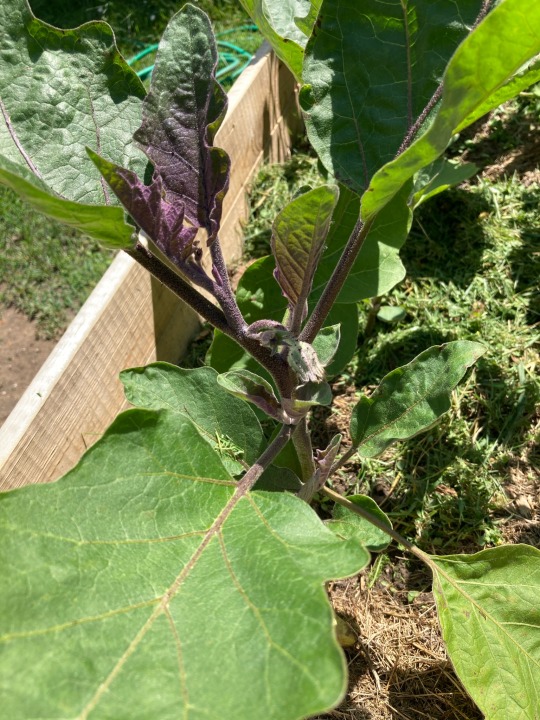
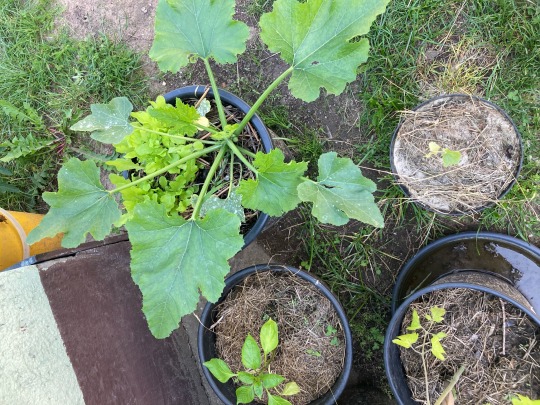
- Lettuce, tomatoes, zucchinis, and sunflowers are getting HUGE
- Ruccola is not growing very well, I might have to find a less sunny spot for them

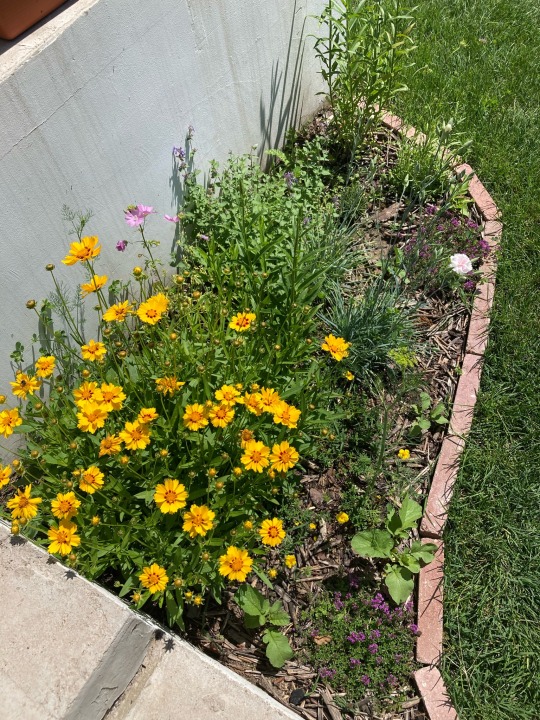
- Coreopsis just started blooming
- I got hooked on growing microgreens, I will post a separate little article about it later


#solarpunk#gardening#garden#sustainability#permaculture#garden update#vegetables#container gardening#growing food#balconygarden#raised beds#self sufficiency
73 notes
·
View notes
Note
Started digging my raised garden bed today. Going to apply some hugelkultur concepts so I don't need as much soil to fill it in. I've also been amassing leaves from my driveway/gutters/etc to turn into soil, and it's going well so far- a whole container of former leaves, turned into good soil almost, in only a week! Plus my compost pile is chugging along, making great compost from vegetable scraps.
This is awesome!!!! That's a lot of hard work your putting in, congrats on all of that!!

Enjoy some snacks and rest in between!
#sleepover saturday#projects#good news#i truly love this!! i hope it all turns out how you want it to#solarpunk#hopepunk#gardening#asks#mail#bestie
16 notes
·
View notes
Text

The part-shade beds are lined, mulched, and surrounded by paths. They're partially-buried hugelkultur mounds, which we put in 3 years ago, but they've never quite been productive and I've been terrible about maintaining them. I wish I had some before pics but it was so weedy it was kind of hard to photograph.
The nettles in the lower bed are promising -- the groundhog leaves them alone, they provide several harvests of tasty greens, they're perennial and shade-tolerant, and I might figure out how to harvest fiber from the stalks. The upper bed has some daylilies which I'll harvest for tubers once they spread a little more.
As for the middle bed, I just got five lbs of mushroom spawn:

I tried wine caps once already but I don't think I gave them adequate substrate so they didn't produce very much. I also overloaded the middle bed with nitrogen (composted sheep manure) last year and definitely killed off the mycelium in that one :( Added a bunch of shredded cardboard for carbon and a little bit of compost. If this experiment goes well, I'll invest some effort into creating a huge mushroom bed along the north fence line.
I mulched the beds weeks ago and almost forgot that I also threw some cress seeds down under the mulch toward the bottom of the mushroom bed. So far the pests have avoided my other cress patch, so I'm happy to have finally discovered some greens I can grow and actually get to eat. The motherfuckers DESTROYED my sochan this year, which is weird because they've left it alone for so long :'(
4 notes
·
View notes
Text
I went on one of those Buy Nothing groups and asked for small logs and branches. People were pretty excited for the free yard cleanup and I brought home so much wood!
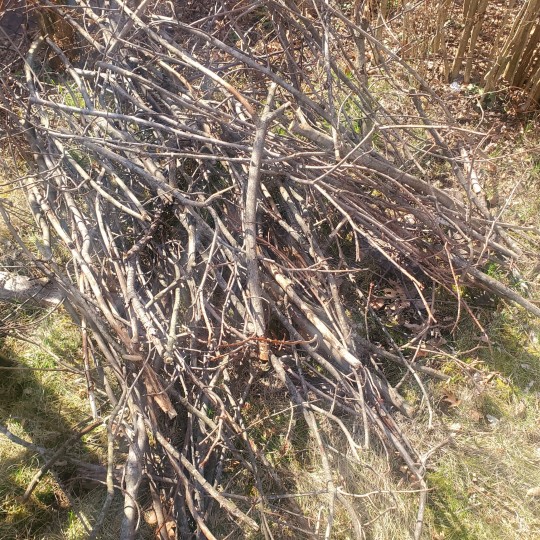

I'm going to convert my current vegetable garden to a native pollinator garden and use some of these logs and branches to start a hugelkultur raised bed. There's a huge area of bare soil in the yard where we had one of those tiny Intex pools, which I'm rehoming. I just don't have enough space or privacy for a pool and last year one of our cardinal fledglings fell into it (and quickly escaped thanks to critter pool ramps), so it's a safety concern for the wildlife.
The bare patch of soil is going to be a big vegetable, flower, and herb garden, with the hugelkultur positioned in the center. I'm hoping all the decaying wood, leaf litter, compost, and grass clippings from the hugel will yeild a nice healthy layer of soil. Leftover logs will be used to grow mushrooms and some of the smaller branches will be piled in a corner for fireflies and overwintering insects.
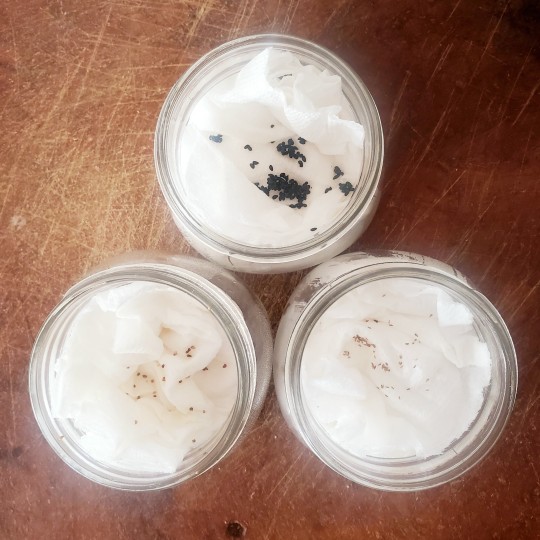
I also bought some native seeds for the pollinator garden. Right now I've got Wild Strawberry, Early Goldenrod, Red Columbine, and Spotted Touch-Me-Not in the fridge for stratification.
I've got Purple Coneflower started in pots and a packet of Blue Flag Iris seeds, which I'll be planting this autumn. We also have some American Cranberrybush and Bloodroot seeds, but I won't be starting those yet since they have double dormancy requirements. We already have Bloodroot in the garden but I want to plant even more.
At some point I want to try my hand at building a tiny pond for vernal pools. We have a slug problem so I really want to encourage toads and salamanders. I'm not sure if I want to do something above ground with lots or ramps and hiding spots or something in-ground but very shallow, like 6"-8" maximum depth.
It's going to be a busy spring!
7 notes
·
View notes
Text
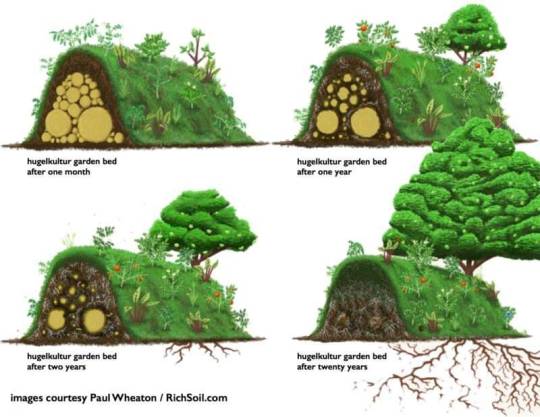
Hugelkultur:
A link from MSU Extension Master Gardeners regarding this fascinating form of gardening. Hugelkultur incorporates a compost pile directly into the garden bed:
https://mgsoc.org/2019/01/hugelkultur-what/
Below, another diagram and examples of what a finished Hugelkultur garden might look like.
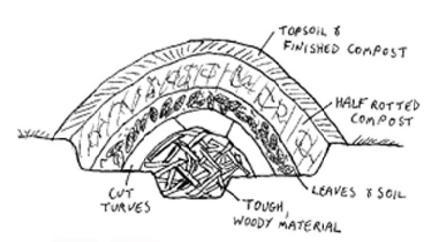


11 notes
·
View notes
Text
do you think Zoro would drunk garden with me? I've been drunk gardening for the past 2 hrs. but the thing is, I'm making these garden beds called hugelkultur where you dig a bunch of shallow graves for your enemies and fill them with rotting logs and stick and compost and I've fallen into them like 10x..... there's like 20 of these shallow 3x6 graves and my dumbass keeps forgetting about them.... if only Zoro was home from the pirate life to help me up.
#i know he would bc hes my wife and we drunk garden together sll the time#when hes not pirating#anyways the harvest will be bountiful#...nxt yr#hugelkultur is an art and i guess it will take 1-3yrs for them to fully take off#but its economic!!!#the rotting wood feeds and waters your plants for 3-10yrs#our will have a life expectancy of 3-5yrs bc were using a medium density wood#that's not fully rotted#yeehaw#i downed like 5 shots of that pink whitney and just gardened my ass off#and fell a lot#there's a lot of holes....#and sticks.....#and logs#and compost
3 notes
·
View notes
Note
For the record that person who mentioned "shoveling up into a mound" may have been referring to hügelkultur, it's a German style of gardening that utilitizes the sides of the mounds for growing space and is a bit more structurally stable than a simple mound of compost. Still not sure if that would help re: knees and ankles, but I just thought I'd put in my two cents
Hugelkultur tends to create long mounds, not the steep-sided structures I want, and also wouldn't work at the angle I'm building (directly down the sides of a very steep hill with high rainfall). I'm gonna do stairstep-shaped raised beds with sides.
I do plan on using hugelkultur mounds in the larger area of my yard to build gardens that can properly manage the water flow because right now it's just a wild zone of periodic mud and dust out there depending on the weather, but it'll be a few years before I can afford to get the big trees cut down that I want to use for it (they're mostly dead and if I don't get then cut down they will eventually fall on my house). But these beds are for higher maintenance vegetables and in a fairly limited and uncooperatively-shaped space so I want them high up and reachable without bending over or climbing anything. I've decided to build them out of sleepers (for framing) with tin sides, which seems to be the cheapest and most easy-to-assemble option. In a decade or so I might be able to put together something better but I have too many house maintenance tasks to pay for to be fancy right now.
39 notes
·
View notes
Text
Hugelkultur Raised Bed (@prirodneazdrave) #gardening
youtube
MARCEDRIC KIRBY FOUNDER CEO.
MARCEDRIC.KIRBY INC.
WELCOME TO THE VALLEY OF THE VAMPIRES
0 notes
Text
Hugelkultur Raised Bed (@prirodneazdrave) #gardening
youtube
MARCEDRIC KIRBY FOUNDER CEO.
MARCEDRIC.KIRBY INC.
WELCOME TO THE VALLEY OF THE VAMPIRES
0 notes
Text
Reaping The Rewards Of Spring Planning
This month is heavy on the picking and light on the work. Why? Because I worked hard in the spring to create this exact scenario. Water-wise, deep beds have yielded incredible amounts of produce. See how we built them here: Hugelkultur, Keyhole Gardens: Bridging Ideas and here: Mother’s Day Raised Hugelkultur Bed! Hugelkultur/keyhole garden inspired bed. These will have worm bins in the middle in…
0 notes
Text
Reaping The Rewards Of Spring Planning
This month is heavy on the picking and light on the work. Why? Because I worked hard in the spring to create this exact scenario. Water-wise, deep beds have yielded incredible amounts of produce. See how we built them here: Hugelkultur, Keyhole Gardens: Bridging Ideas and here: Mother’s Day Raised Hugelkultur Bed! Hugelkultur/keyhole garden inspired bed. These will have worm bins in the middle in…
0 notes